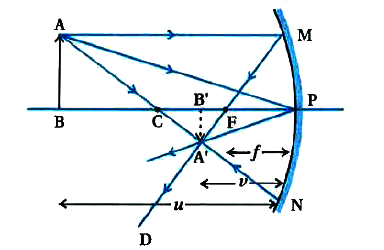Derive i+e=A+δ for a triangular glass prism.Solution in Gujrati
In figure the cross-section perpendicular to the rectangular surface of a prism made up of a transparent medium is shown.

A ray of monochromatic light is incident at point Q on the AB surface of the prism.
According to Snell.s Law, it is refracted and travels along path QR. It experiences deviation δ1, at point Q.
Ray QR is incident on surface AC at point R and suffering deviation δ2, due to refraction emerges in the direction RS.
If the incident ray PQ is extended it advances in QE direction. When the emergent ray RS is extended backwards it meets PE in D.
Incidence angle : Angle made by incident ray at a point on surface with normal is called incidence angle.
∠PQK=i
Refracted angle : Angle made by refracted ray at a point on surface with normal is called refracted angle. ∠RQL=r1, and ∠QRL=r2
Emergence angle : Angle made by emergent ray with normal of surface is called emergence angle.
∠TRS = e
Angle of Deviation : “Angle between incident ray and emergent ray is called angle of deviation (δ)”.
∠εDS=δ
In the figure in □AQLR,
∠AQL=90∘ and ∠ARL=90∘ are right angle.
∴∠A+∠QLR=180∘ ... (1)
Now, in △QLR
r1+r2+∠QLR=180∘ ...(2)
From equation (1) and (2),
r1+r2+∠QLR=∠A+∠QLR=180∘
∴r1+r2=∠A ... (3)
From the geometry of the figure angle of deviation δ is the exterior angle for ∠DQRi.e.∠EDS=∠DOR
∴∠EDS=∠DQR+∠DRQ
∴δ=δ1+δ2
but, ∠DQR=∠DQL–∠RQL
δ1=i−r1 [∵∠PQK=∠DQL=i]
and,∠DRQ=∠DRL−∠QRL
δ2=e−r2
[∵∠DRL=∠TRS=e]
So, equation (4)
δ=i−r1+e−r2
δ=i+e−(r1+r2)
∴δ=i+e−A [∵ equation (3)]
∴i+e=A+δ
This equation gives the relation between angle of deviation, angle of incident, angle of emergence and angle of prism.
From above equation we say that angle of deviation depends on the angle of incidence.
Topper's Solved these Questions
- RAY OPTICS AND OPTICAL INSTRUMENTSBook:KUMAR PRAKASHANChapter:RAY OPTICS AND OPTICAL INSTRUMENTSExercise:SECTION - A (TRY YOURSELF)
Explore 74 Videos
- RAY OPTICS AND OPTICAL INSTRUMENTSBook:KUMAR PRAKASHANChapter:RAY OPTICS AND OPTICAL INSTRUMENTSExercise:SECTION-B (NUMERICALS)(NUMERICAL FROM TEXTUAL ILLUSTRATIONS)
Explore 17 Videos
- MOVING CHARGES AND MAGNETISMBook:KUMAR PRAKASHANChapter:MOVING CHARGES AND MAGNETISMExercise:SECTION D (MCQs ASKED IN COMPETITIVE EXAMS)
Explore 34 Videos
- SAMPLE QUESTION PAPER Book:KUMAR PRAKASHANChapter:SAMPLE QUESTION PAPER Exercise:PART-B SECTION-C
Explore 5 Videos
Similar Questions
Give range of wavelength of visible light.
View SolutionSuppose that the lower half of the concave mirror.s reflecting surface as shown in figure is covered with an opaque (non-reflective) material. What effect will this have on the image of an object placed in front of the mirror ?

View SolutionElectric charge Q having mass M moves on a circular path of radius R with velocity →v, perpendicular to uniform magnetic field B. When a particle completes one revolution, work done by the field is _______
View SolutionTwo charges –q and +q are located at points (0, 0, –a) and (0, 0, a), respectively.
(a) What is the electrostatic potential at the points (0, 0, z) and (x, y, 0) ?
(b) Obtain the dependence of potential on the distance r of a point from the origin when r/a>>1 .
(c) How much work is done in moving a small test charge from the point (5,0,0) to (–7,0,0) along the x-axis? Does the answer change if the path of the test charge between the same points is not along the x-axis?
View SolutionTriangular prism a prism is called triangular prism if its ends are triangles.
View SolutionRight triangular prism a right prism is called a right triangular prism if its ends are triangles.
View Solutionएक त्रिभुजाकार प्रिज्म के लिये विचलन कोण (δ) तथा आपतन कोण (i) में ग्राफ व्यक्त होता है :
View SolutionHow many triangular bases is there for a glass prism ?
View SolutionOut of ______ faces of a triangular prism, ______ are rectangles and ______ are triangles.
View Solutionसंलग्न चित्र में दो प्रिज्मों X और Y के लिए प्रिज्म के कोण A और विचलन कोण δ के मध्य ग्राफ प्रदर्शित किया गया है। इनमें से कौन-सा क्रॉउन -काँच का तथा कौन-सा फ्लिण्ट - काँच का प्रिज्म होगा ?

View SolutionDerive i+e=A+δ for a triangular glass prism.
View SolutionExplain the phenomenon of refraction through prism. Derive the following relation between angle of prism and angle of deviation. ∠i+∠e=∠A+∠δ.
View SolutionWhat is a triangular glass prism?
View SolutionState the causes of dispersion of white light as it passes through a triangular glass prism.
View SolutionA triangular glass prism has ......... triangular bases and ......... rectangular surfaces.
View SolutionExplain refraction of light through a prism and derive relations: i + e = A + delta
View Solution

